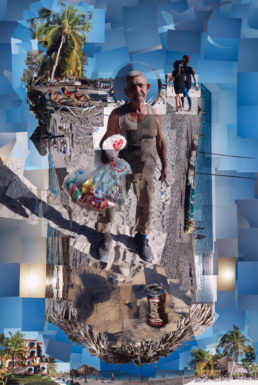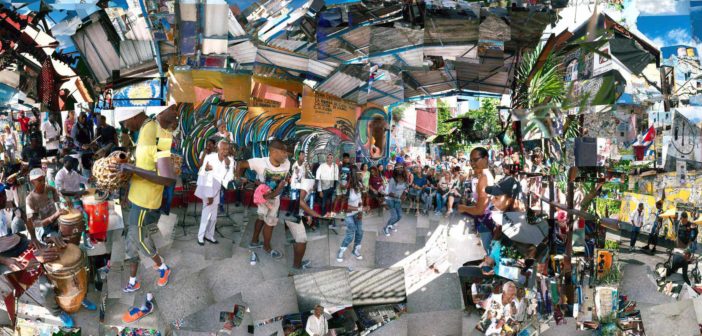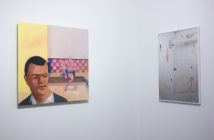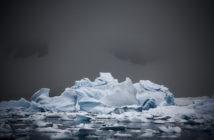Despite an increase of U.S. citizens traveling to Cuba in the recent past, the popular American image of that island nation remains a combination of ‘50s cars and fine cigars, symbols of a discourse stuck on insularity and trade restrictions. Northampton, MA photographer Mark Guglielmo is more interested in how Cubans see themselves. Cubaneo, his exhibition of large-scale “photo-mosaics” on view through October 27 at Villa Victoria Center for the Arts’ La Galería in Boston, takes its title from a term used by Cubans to reference ways in which their contemporary identity is expressed. While the Caribbean colors and rhythmic compositions are visually arresting, Guglielmo’s images are only partly about an American photographer exploring the sights and sounds of a foreign country. More importantly, he does his best to suggest the complexity of “Cubaneo.”
Cubaneo comprises a selection of manually collaged photo-mosaics from Guglielmo’s three recent journeys to cities across Cuba, starting with a trip organized by a Cuban-American friend from Northampton in 2015. Guglielmo relied on a network of new friendships to gain access beyond tourist hot spots. The dizzying Escuela Primaria Guerrillero Heroico / Heroic Guerrilla Elementary School was made possible through fellow artist Vladimir Rodríguez, who vouched for Guglielmo at his daughter’s school in Cienfuegos, where he was allowed to photograph morning assembly.
Wearing bright red and white uniforms with neckerchiefs and black berets (worn in honor of Che Guevara), the students in Escuela Primaria Guerrillero Heroico stand to attention while the architecture breaks apart and bends to show more than is visible at a single glance. Some students float above the others, literally elevated by their performative gestures: saluting and flag-raising. Portraits of Che Guevara and Fidel Castro look on from the shadows, but they are small, and the viewer must look hard to find them all.

Mark Guglielmo, Callejon de Hamel.
Escuela Primaria Guerrillero Heroico presents an anomaly. It is the only school in Cuba to wear that uniform and focus its teachings on Che Guevara’s texts. This assembly of schoolchildren embodies a dream version of modern Cuba that attempts to create a clear channel from the nation’s past towards its future. In contrast, Guglielmo alludes to the wounds of the past by hand-tearing photos of family members impacted by revolution-era violence and subsequent separation into tiny segments before taping them together again in La Familia Lucero / The Lucero Family. Here, history is not glorified. Even so, both present a current moment marked by positivity, as, reunited, the family smiles at one another and for the camera.
Stylistically, Guglielmo’s photo-mosaics are defined by information overload and the mechanics of collage. While he merges curvilinear perspective with a panoramic format that acts as an homage to the camera lens, humble scissors and tape are arguably even more important tools. Back in Northampton, hundreds of photographs (in Escuela Primaria Guerrillero Heroico’s case, 1200) are manually cropped, rearranged, and taped together until they form panoramas that approach analytic cubism. Simultaneity becomes a key theme that suggests the difficulty of defining Cubaneo.

Mark Guglielmo, Lincoln Camue.
Photos from two different days merge in La Familia Sánchez en Casa / The Sánchez Family at Home. Guglielmo describes his arrangement of the final piece as a “jazz-like improvisation.” Nonetheless, the combination of compositional balance with the family’s casual poses is a choreographic achievement—and a witty way to depict the odd, public facing moments of private live, such as entertaining friends. Similarly, in El Pintor Lincoln Camué / The Painter Lincoln Camué Guglielmo mirrors the scene around a central, vertical axis, warping buildings so that entrance to the Cuban painter’s studio mimics the pupil of a giant eye. Camué is depicted twice, and his double gaze beyond the picture plan suggests the role of the artist in Cuban society as lookout, or seer.
Elsewhere, Guglielmo finds saints. In Bucanero en Playa Ancon / Buccaneer at Ancon Beach, a man gathering cans on a sandy beach in Trinidad de Cuba is presented like a figure on a prayer card. The sky arcs around his head in a delicate halo. He stares directly at the viewer, holding his bag of trash the way martyrs present their symbols. In the distance, couples sunbathe or stroll hand-in-hand. Bucanero en Playa Ancon’s composition is relatively simple, but through symbols and styling it references many dichotomies at play: religion versus secularism, work versus leisure, trash versus treasure.

Mark Guglielmo, Bucanero en Playa Ancon / Buccaneer at Ancon Beach.
Throughout Cubaneo, multiple perspectives and moments in time coexist in ways that suggest the term cannot be defined by a single outlook. Guglielmo presents mesmerizing complexity, and American viewers wanting a more clear-cut snapshot of a nation may find these works too subtle, aestheticized, and open-ended. Whether a Cuban audience would feel the same way is up to debate, at least until Cubaneo travels to galleries in Cienfuegos and Trinidad in 2018. In a country where the concept of Cubaneo doesn’t have to be explained, a major hurdle between the artwork’s intent and the audience disappears. Yet to quibble about whether or not the exhibition adequately conveys a multifaceted aspect of the Cuban experience is to miss the other point Cubaneo makes, which is particularly prescient for Americans today. Travel opens doors, but it is up to ourselves to step beyond the threshold, to interact in a new language and see from another’s point of view.




